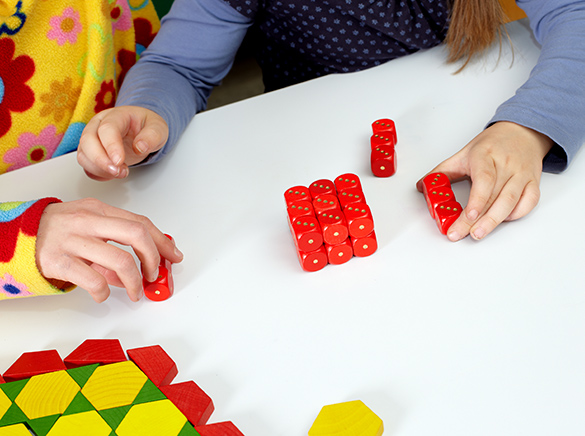Minds On
Is it fair?
Student Success
Think-Pair-Share
Solve the word problem. Share your ideas in your notebook. Use math language to communicate your thinking as much as possible.
Two players each create a game.
Player #1's game
Player #1 creates a game with a number cube with numbers 1, 2, 3, 4, 5 and 6.
In this game, Player #1 wins if an odd number is rolled. Player #2 wins if an even number is rolled.

Is this game fair? Justify your answer using pictures, numbers (including fractions), and words.
Player #2's game
Player #2 creates a game using a spinner with numbers 1, 2 and 3.
In this game, Player #1 wins if the spinner lands on an even number. Player #2 wins if the spinner lands on an odd number.

Is this game fair? Justify your answer using pictures, numbers (including fractions) and words.
Note to teachers: See your teacher guide for collaboration tools, ideas and suggestions.
Let’s review an explanation to compare the games.
Press the 'Comparison of games' to reveal solutions.
Player #1's game is fair.
In Player #1's game, there are 6 possible results. You can roll a 1, 2, 3, 4, 5 or 6. Out of those results, 3 numbers out of 6 are odd numbers. 3 numbers out of 6 are even numbers.
We can represent those numbers as fractions: Odd: Even:
When we look at the fractions, they are the same. We know then that there is an equal chance of getting a result that is an odd number as there is of getting an even number. The game is fair.
Player #2's game is not fair.
In Player #2's game, there are 3 possible results. You can roll a 1, 2 or 3. Out of those results, 2 numbers out of 3 are odd numbers. 1 number out of 3 is an even number.
We can represent those numbers as fractions: Odd: Even:
When we look at the fractions, they are not the same. There are 2 ways to win with odd numbers as the numerator represents. There is 1 way to win even numbers as the numerator represents. The game is not fair.
We can use fractions to compare one value to another. In this example, we compared odd numbers and even numbers. Each fraction represents the number of odd values in the game and the number of even values in the game.
Another way to compare values is to use Ratios.
Action
What is a ratio?
A ratio is a way to compare quantities. In other words, how much of one there is in comparison to how much of another thing.
For example, the number of triangles to squares:


We can write the ratio as 1:2 or 1 to 2 or
Representing ratios
There are 3 ways to represent ratios:
We can write ratios as a number statement with a “:” separating 2 values.
Example:
1:2
We can use the word “to” to compare the 2 values.
Example:
1 to 2
We can use a fraction to compare the 2 values.
Example:
1 and 2 in a ratio are called terms.
Types of ratios
Part to whole ratios
A ratio can show a part compared to a whole.

What is the ratio of red heart balloons to total balloons?
1:5
There is 1 red balloon to 5 total balloons.
What is the ratio of blue balloons to total balloons?
4:5
There are 4 blue balloons to 5 total balloons.
Part to part ratios
A ratio can show a part compared to another part. This example shows red heart balloons (part) compared to blue balloons (part).

What is the ratio of red heart balloons to blue balloons?
1:4
There is 1 red heart balloon to 4 blue balloons.
Let’s recall what we have learned about ratios.
- A ratio is a comparison of two quantities
- Ratios are of two types:
- part:part
- part:whole
- Ratios can be represented as:
- x to y or x:y or
Student Success
Think-Pair-Share
Solve the following word problems. Use what we have learned about part to part and part to whole ratios to solve. Record your answers in a video clip and include math language to show your thinking.
Question:

- What is the ratio of scented pencil crayons to total pencil crayons?
- What is the ratio of scented pencil crayons to unscented pencil crayons?
- Write your ratios 3 different ways.
Note to teachers: See your teacher guide for collaboration tools, ideas and suggestions.
Scale up strategy
We can create equivalent ratios which are ratios that have the same value. When we multiply the parts of the ratio by the same number, that is called scaling up.
 Description
Description
A ratio of 1 to 2 is shown using one eight sided shape and two circles. An arrow points to a ration of 2 to 4, a group of 4 circles and 2 eight-sided shapes.
In the example, there is 1 yellow octagon to 2 purple circles. The ratio is 1:2 or 1 to 2.
We can scale up this ratio to 2:4 or 2 to 4 by multiplying the 1 yellow octagon by 2 and the 2 purple circles by 2.
Now, we have two equivalent ratios because they show the same value or make the same comparison.
Discussion
Question:
Cows and sheep are eating grass together on a field. The ratio of cows to sheep is 1 to 5. If there are 30 animals altogether, how many cows and how many sheep are on the field?
There are many ways to think about this problem and create a solution.
Press the "Solution" button to reveal the answer.
We can write the ratio of cows to sheep as 1:5. This means that the total number of animals is 6 because 1 + 5 = 6.
If there are 30 animals altogether. We know we have to create a scaled-up ratio where the parts add up to 30.
We can use a number line to model my solution.
 Description
Description
Two number lines stacked atop each other. One is labeled Number of cows and is labeled 1, 2, 3, 4, 5. The other is labeled Number of sheep and is labeled 5, 10, 15, 20, 25. The last numbers on each line are circled.
We see on the number line that 5 cows are in the same position on the number line as 25 sheep.
When we add the parts together, they total 30 animals.
We can also check using multiplication.
I also know that 6 × 5 = 30. I can multiply both parts of the ratio 1:5 by 5. The scaled-up ratio is 5:25.
There are 5 cows and 25 sheep on the field.
Student Success
Think-Pair-Share
Solve the following word problem. Share your answers in your notebook.
Question:
Runner #1 and Runner #2 ran laps to train for their race. The ratio of laps Runner #1 ran to the number of laps Runner #2 ran was 1:10.
On Sunday, Runner #2 ran 30 laps. How many laps did Runner #1 run? How many laps did they run altogether?
On Monday, Runner #1 ran 4 laps. How many laps did Runner #2 run? How many laps did the run altogether?
Compare the number of laps Runner #1 and Runner #2 ran each day using a ratio.
Use a variety of representations to show your thinking.
Note to teachers: See your teacher guide for collaboration tools, ideas and suggestions.
Consolidation
Word problem and game time!
Solve the following word problem using the concepts you learned in this ratios lesson. Use a variety of representations to show your thinking.
Question:
25 students take piano lessons from Music Teacher #1.
The ratio of students who take piano lessons from Music Teacher #1 to guitar lessons from Music Teacher #2 is 1 to 2.
How many students take guitar lessons from Music Teacher #2?
The ratio of the number of students who take guitar lessons from Music Teacher #2 to drumming lessons from Music Teacher #3 is 1 to 5.
How many students take drumming lessons from Music Teacher #3?
How would your answers change if the number of students who take piano lessons doubled? Use pictures, numbers and words to show your thinking.

Game time!
Recall Player #1 and Player #2 from our Minds On activity. Player #1 created a game that was fair and Player #2 created a game that was not fair.
Create your own game to share with friends or family members. Use what you know about ratios to ensure the chances to win the game are fair.
You may use number cubes, spinners, dominoes, playing cards or something else of your choice.
Play the game with your friend or family member 5 times and record the number of wins to loses.
Make some predictions: If you played the game 20 times, what would be the ratio of wins to loses? What about 20 times?
Create an advertisement for your game. Record a video clip or write down your description of the game, how to play and why it is fair. Use math language in your description.

Reflection
How do you feel about what you have learned in this activity? Which of the next four sentences best matches how you are feeling about your learning? Press the button that is beside this sentence.
I feel...
Now, record your ideas about your feelings using a voice recorder, speech-to-text, or writing tool.